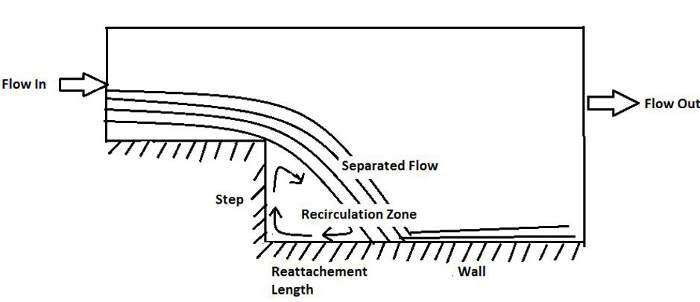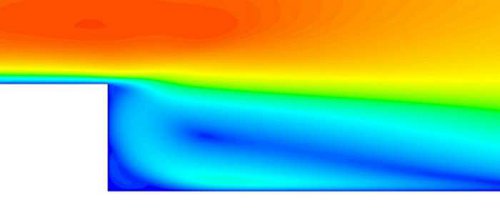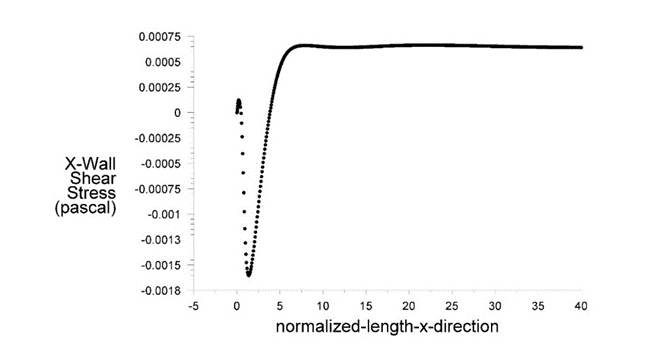Tutorial: CFD Simulation of Backward Facing Step
This tutorial is a well-known academic problem that one should solve while learning CFD. One of the objective is to learn the process of solving backward step problem, but the important objective is to understand standards of getting solution for such physics. This tutorial is based on CFD modeling software ANSYS FLUENT and will cover simulation steps and post processing required to solve steady state, turbulent flow over backward facing step.
| ANSYS FLUENT |
| Beginner |
| No Specific Industry. Academic Validation Problem |
| Academic Problem Series |
| Trushna Dhote & Sanket Dange |
| CFD, ANSYS FLUENT, Backward Facing Step, Flow Separation and Reattachment Length |
| Course : CFD Simulation with ANSYS FLUENT |
This tutorial is part of our FREE course "CFD Simulation with ANSYS FLUENT". Visit the course page to see the details of the course and subscribe the course.
Instruction to Download PDF Instruction, Input and Solution Files
A PDF copy of this tutorial guide is provided for download. This tutorial guide includes step by step instructions to repeat and try this tutorial on your own. A necessary input mesh file is available for download. ANSYS FLUENT solution files (case and data file) is also available for download and check the simulation setup details and verify your results.
All these files are available in the download section of this tutorial. You need LearnCAx account to download all the files. If you do not have an account, create your FREE LearnCAx account here. Just login with your LearnCAx account and you will see all these files in the download section provided at top.
Introduction
Many industrial application involves flow separation and reattachment. To illustrate the above phenomenon, flow simulation over backward facing step is considered. This tutorial is based on CFD modeling software ANSYS FLUENT. A mesh file is provided as input for this tutorial (This tutorial will not cover mesh generation steps). The tutorial will cover simulation steps and post processing required to solve steady state, turbulent flow over backward facing step problem using ANSYS FLUENT software.
This tutorial is a well-known academic problem that one should solve while learning CFD. One of the objective is to learn the process of solving backward step problem, but the important objective is to understand standards of getting solution for such physics. There is large literature available for analytical and experimental methods for this problem. One should validate the CFD results with such available data to get confidence on CFD simulation.
Following are few of the resources from where you can obtain the data for validation:
- http://turbmodels.larc.nasa.gov/backstep_val.html
- http://www.grc.nasa.gov/WWW/wind/valid/backstep/backstep01/backstep01.html
- T. Lee and D. Mateescu. ‘Experimental and Numerical Investigation of 2-D Backward-Facing Step Flow’, Journal of Fluids and Structures (1998) 12, Page No: 703 – 716
- B. F. Armaly, F. Dursts, J. C. F. Pereira and B. Schonung. ‘Experimental and Theoretical Investigation of Backward-Facing Step Flow’, Journal of Fluid Mechanics 01/1983; Page No: 473 - 496.
Objective of Tutorial
The main objective of this tutorial is to provide step by step guide to solve backward facing step problem using ANSYS FLUENT software. All the steps right from providing inputs for flow simulation to post-processing and result interpretation are covered in this tutorial. The flow device used for this tutorial is a simple duct with backward facing step but the same steps and physics also applies to much more complicated shapes and devices.
Prerequisite
Following are the prerequisites for using this tutorial:
- You should have basic understanding of fluid mechanics
- You should be familiar with ANSYS FLUENT software interface
- You should have access to ANSYS FLUENT software
- We tried to provide detailed explanation about each step. Some of the steps might not include very minor details about doing setup in ANSYS FLUENT. It is assumed that you are familiar with ANSYS FLUENT and solved coupled of simple CFD problems
- It is recommended that you have a computer system with 2 GB to 4 GB RAM in order to setup and run this tutorial simulation
- You should have access to PDF file reader to read this PDF file
Benefits of Tutorial
After this tutorial, you should be able to:
- Able to solve simple flow problems using ANSYS FLUENT
- Use K-e Realizable model (Turbulent Model) to analyse this problem
- Set-up the case with appropriate material, boundary conditions and solver settings
- Post process the results to determine the reattachment length of a separated flow and visualize the phenomenon of flow separation using vector and contour plots
- Create Custom Field Functions in ANSYS FLUENT
- Crete XY plots
What is Backward Facing Step Problem?

Figure : Flow Features of Backward Facing Step Flow
Fully developed flow enters the domain from left. When the flow reaches the step, because of expansion of flow channel, pressure gradient exists, it detaches and a recirculation zone is formed. A turbulent boundary layer encounters a sudden back step, causing flow separation. Later the flow eventually reattaches to the bottom wall.
Importance of Backward Facing Step Problem
Separation and reattachment of turbulent flows occur in many practical engineering applications. It is seen both in internal flow systems such as diffusers, combustors and channels with sudden expansions, and in external flows like flow around airfoil and building. In these situations, the flow experiences an adverse pressure gradient (to know more visit: https://en.wikipedia.org/wiki/Adverse_pressure_gradient), which causes the boundary layer to separate from the solid surface. The flow subsequently reattaches downstream forming a recirculation bubble. The presence of a separated flow, together with a reattaching flow, gives rise to increased unsteadiness, pressure fluctuations which may lead to structure vibrations and noise.
The flow over a backward facing step provides an example of above said flow field. The flow separation and reattachment phenomenon are studied using velocity vector and XY plots. The plots of shear stress vs recirculation length (normalized by step height) is generated.
CFD Problem Description
The CFD domain consists of inlet, backward facing step and an outlet. A developed steady turbulent flow enters through the inlet, passes over the step where it detaches from the boundary and further reattaches at a particular length. Air enters inlet at velocity of 0.3781 m/s, travels through a distance of 0.4 m (inlet channel length) and passes through step of height 0.04 m (step height H). Outlet channel length is 1.6 m whereas inlet channel height and outlet channel height are 0.2 m and 0.24 m respectively.
Density of air is 1.23 kg/m3 while dynamic viscosity is 1.86 * 10-5 Ns/m2. From this given data the calculated Reynold’s number at inlet is 5000. Following 2D flow domain is considered for this analysis.

Figure : CFD Flow Domain
CFD Solution Snippets
These are the few snippets of CFD simulation results from this tutorial

Figure : Contour Plot of Velocity

Figure: X-Wall Shear Stress vs. normalized-length-x-direction
Tutorial Contributor(s)
{module [312]}
{module [326]}